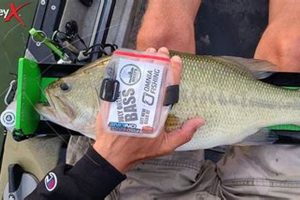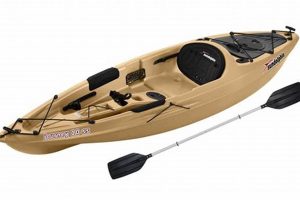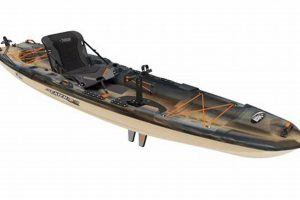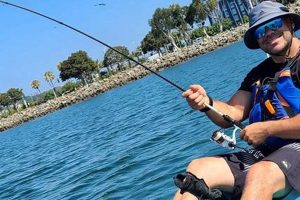Mounted devices designed to secure fishing rods on kayaks come in various forms, including flush-mounted, adjustable, and rotating models. These often incorporate features like rod leashes and adjustable angles to accommodate different fishing styles and rod types. For instance, a rotating mount allows anglers to easily switch between trolling and casting, while a flush-mounted holder maximizes deck space.
Secure rod storage is essential for kayak anglers. It prevents rod loss or damage during navigation, paddling, and landing fish. Furthermore, it frees the angler’s hands for other tasks, like paddling, adjusting lures, or handling fish. Historically, anglers improvised with simple straps or clips. The development of specialized holders reflects the growth and specialization of kayak fishing, demonstrating a need for more efficient and secure rod management on the water.
This article will explore the diverse types of mounts available, discuss factors influencing selection, and provide guidance on installation and maintenance. Topics covered include material considerations, mounting locations, compatibility with different kayak types, and recommended accessories.
Tips for Choosing and Using Rod Holders
Optimal rod holder selection and usage enhance safety and fishing effectiveness. Consider these guidelines for a successful kayak fishing experience.
Tip 1: Consider Fishing Style: Different fishing styles necessitate specific holder types. Trolling requires holders capable of withstanding constant pressure, while casting benefits from easily accessible, adjustable mounts.
Tip 2: Evaluate Kayak Compatibility: Ensure chosen holders are compatible with the kayak’s material and mounting locations. Track-mounted systems offer flexibility, while flush-mounted holders require careful consideration of deck space.
Tip 3: Prioritize Secure Mounting: Correct installation is critical. Use appropriate hardware and mounting techniques to ensure holders remain firmly attached during challenging conditions.
Tip 4: Select Durable Materials: Opt for corrosion-resistant materials like marine-grade stainless steel or high-impact plastic to withstand the harsh marine environment.
Tip 5: Adjust Holder Positioning: Position holders to minimize interference with paddling and other onboard activities. Optimal placement provides easy access without compromising stability.
Tip 6: Utilize Rod Leashes: Rod leashes provide an additional layer of security, preventing loss in the event of capsizing or unexpected strikes.
Tip 7: Regular Maintenance: Inspect holders regularly for wear and tear. Tighten loose screws and replace damaged components to ensure continued performance.
Proper selection and usage of these devices contribute significantly to a safe and enjoyable fishing experience. By adhering to these guidelines, anglers can optimize their equipment setup and focus on the task at hand.
In conclusion, selecting and using appropriate rod holders is a crucial aspect of kayak fishing.
1. Types
Categorizing fishing rod holders by type is essential for matching specific needs and kayak configurations. Understanding the distinctions between available options allows for informed decisions that enhance fishing effectiveness and overall experience.
- Flush Mount Holders
Integrated directly into the kayak’s surface, flush mount holders offer a streamlined profile, minimizing interference with paddling and movement. They are ideal for anglers prioritizing a clean deck layout. However, their fixed position offers limited adjustability. Examples include molded-in receptacles and aftermarket mounts designed for specific kayak models. Their low profile can make rod retrieval slightly more challenging compared to elevated options.
- Adjustable Holders
Adjustable holders provide flexibility in rod positioning. These holders typically feature a rotating or pivoting mechanism, allowing anglers to adjust rod angles for trolling, casting, or storage. Examples include adjustable track mounts and clamp-on holders with articulating arms. This adaptability makes them suitable for diverse fishing techniques and changing water conditions. However, they may require more deck space than flush mount options.
- Rail Mount Holders
Designed for kayaks equipped with accessory rails, rail mount holders offer convenient installation and removal. They slide onto the rails and secure with screws or clamps, providing a secure platform for rod placement. Examples include rod holders with adjustable angles and those designed for specific rail systems. This type excels in versatility and ease of use, especially when frequent adjustments or removal are desired. Compatibility is limited to kayaks with compatible railing systems.
- Rotating Holders
Rotating holders allow 360-degree rod rotation. This feature is particularly beneficial for trolling, allowing the rod to follow the lure’s movement and reducing line twist. Examples include holders with rotating bases and those integrated into adjustable mounts. While advantageous for trolling, the rotating mechanism may add complexity and potential points of failure compared to simpler designs.
The choice of holder type significantly impacts the overall fishing experience. Careful consideration of fishing style, kayak compatibility, and desired adjustability ensures optimal rod management and contributes to a more efficient and enjoyable outing. Selecting the right holder type, therefore, is a crucial step in preparing for a successful kayak fishing trip. By understanding these variations, anglers can tailor their equipment choices to specific needs and maximize their time on the water.
2. Mounting Locations
Strategic placement of fishing pole holders is crucial for efficient kayak angling. Mounting location directly influences accessibility, rod management, and overall kayak stability. Careful consideration of these factors optimizes fishing performance and enhances safety on the water.
- Forward Mounting
Positioning holders near the bow provides easy access and facilitates techniques like casting and jigging. This location is particularly advantageous for sight fishing and working shallow water. However, forward mounting can shift the kayak’s center of gravity, potentially impacting stability. Anglers must balance the benefits of accessibility with potential stability trade-offs, especially in challenging conditions or with longer rods.
- Mid-Ship Mounting
Mid-ship placement offers a balanced approach, minimizing impact on the kayak’s center of gravity. This location is suitable for various fishing techniques and accommodates different rod lengths. While convenient for general use, mid-ship mounting may require reaching further to access rods compared to forward mounting. Anglers should consider the length of their arms and rods when evaluating this location.
- Rear Mounting
Positioning holders behind the angler, often near the stern, is ideal for trolling. Rods extending behind the kayak minimize interference with paddling and maneuvering. However, rear mounting can make rods less accessible for techniques like casting or retrieving lures. Additionally, long rods positioned at the rear increase the risk of entanglement with obstacles or vegetation. Careful consideration of rod length and surrounding environment is crucial when choosing rear mounting.
- Gunwale Mounting
Utilizing the sides of the kayak, or gunwales, offers additional mounting options. This location is suitable for shorter rods used in techniques like vertical jigging or drop-shot fishing. Gunwale mounting maximizes deck space but may require specialized mounts compatible with the kayak’s gunwale design. Stability considerations are also relevant, as adding weight to the sides can affect the kayak’s balance.
Optimal mounting location depends on individual fishing style, kayak type, and target species. Evaluating these factors ensures effective rod management, improves fishing performance, and maintains kayak stability. A well-planned mounting strategy ultimately contributes to a safer and more successful fishing experience.
3. Materials
Material selection for kayak fishing pole holders significantly impacts durability, performance, and resistance to the harsh marine environment. Choosing appropriate materials ensures long-term functionality and contributes to a safe and enjoyable fishing experience. The following materials are commonly used in the construction of these essential kayak accessories.
- Plastic
Plastic offers a lightweight and cost-effective option, often utilized in entry-level or recreational kayak fishing pole holders. Examples include high-density polyethylene (HDPE) and ABS plastic, chosen for their impact resistance and UV stability. However, plastic may be less durable than metal counterparts, susceptible to cracking or breakage under stress or prolonged exposure to sunlight. Its lightweight nature can be advantageous for kayak stability but may compromise strength and longevity compared to more robust materials.
- Aluminum
Aluminum provides a balance of strength, weight, and corrosion resistance. Its lightweight properties make it suitable for kayaks where weight management is critical. Aluminum holders often feature anodized coatings for enhanced protection against saltwater corrosion. While generally durable, aluminum can be susceptible to bending or deformation under significant stress, making it less suitable for extreme fishing conditions or larger, heavier rods.
- Stainless Steel
Stainless steel offers superior strength and corrosion resistance compared to plastic and aluminum. Its robust nature makes it ideal for demanding fishing applications and larger saltwater species. Marine-grade stainless steel, specifically 316 stainless steel, is preferred for its exceptional resistance to saltwater corrosion. While offering the highest durability, stainless steel is heavier than other options and can increase the overall weight of the kayak. This added weight can be a consideration for smaller kayaks or those frequently transported over longer distances.
- Composite Materials
Composite materials, like fiberglass-reinforced polymers, offer a combination of strength, lightweight properties, and corrosion resistance. These materials are increasingly popular due to their durability and ability to withstand harsh marine conditions. Composite holders often feature designs that integrate multiple functionalities, such as rod storage and accessory mounting. While generally more expensive than plastic or aluminum, composite materials offer a premium option with enhanced performance characteristics and longevity.
Understanding the properties of each material allows anglers to select holders best suited to their specific needs and fishing conditions. Balancing factors such as weight, strength, and corrosion resistance ensures optimal performance and prolongs the lifespan of kayak fishing pole holders, contributing to a more enjoyable and efficient fishing experience.
4. Adjustability
Adjustability in kayak fishing pole holders is paramount for optimizing fishing techniques and adapting to dynamic water conditions. A static rod position limits an angler’s ability to effectively present lures, manage lines, and respond to changing currents or fish behavior. Adjustable holders offer a critical advantage by allowing on-the-fly modifications to rod angle and orientation. For instance, trolling requires a specific rod angle to maintain proper lure depth and action, while casting necessitates a different setup for accurate lure placement. Without adjustability, anglers are constrained, potentially missing opportunities or compromising fishing effectiveness. Adjustable holders empower anglers to fine-tune their setup, maximizing their chances of success.
Several mechanisms facilitate adjustability in these holders. Rotating mounts permit 360-degree rod rotation, crucial for techniques like trolling or following a fish’s movement. Pivoting mounts offer vertical angle adjustments, allowing precise control over lure presentation and depth. Sliding track systems provide horizontal adjustability, enabling anglers to reposition holders based on kayak layout and fishing preferences. Furthermore, some holders incorporate quick-release mechanisms, facilitating swift rod retrieval and storage. These diverse adjustment options cater to a wide range of fishing styles and kayak configurations, underscoring the practical significance of adjustability in kayak fishing.
In conclusion, prioritizing adjustability in kayak fishing pole holders directly contributes to enhanced fishing versatility and adaptability. The ability to modify rod position is not merely a convenience but a crucial factor influencing fishing success. Investing in adjustable holders, while potentially adding to initial cost, yields significant long-term benefits by maximizing angling efficiency and responsiveness on the water.
5. Security Features
Safeguarding fishing rods against loss or damage is paramount in kayak fishing. Security features integrated into rod holders play a crucial role in preventing accidental dislodgement during navigation, paddling, or fish fighting. These features enhance angler peace of mind and contribute to responsible equipment management on the water.
- Leashes and Retention Straps
Leashes and retention straps provide a secondary layer of security, preventing rods from being completely lost if they come loose from the holder. These typically consist of adjustable straps or coiled cords attached to the rod and the kayak or holder. For instance, a coiled leash allows free rod movement during casting while preventing loss if the rod is dropped or pulled from the holder by a fish. Such features are essential in dynamic kayaking environments where unexpected movements or strong currents can dislodge unsecured rods.
- Locking Mechanisms
Locking mechanisms secure the rod within the holder, preventing accidental release due to impacts or sudden movements. Examples include rotating collars, lever locks, and cam-action clamps. A rotating collar tightens around the rod butt, securing it firmly in place. These mechanisms provide an added level of security beyond simple friction-based holders, minimizing the risk of rod loss in rough conditions or during intense fish fights. They are particularly important for expensive rods or when fishing in areas with obstacles or strong currents.
- Rod Grips and Inserts
Specialized grips or inserts within the holder enhance rod stability and minimize movement. These often utilize non-slip materials or textured surfaces that increase friction between the rod and the holder. Examples include rubberized inserts or cork-lined grips. These features contribute to secure rod placement, reducing the likelihood of the rod slipping or rotating within the holder, particularly during active fishing or when navigating choppy waters.
- Reinforced Construction
Durable materials and robust construction contribute to overall holder security. High-impact plastics, marine-grade stainless steel, and reinforced mounting brackets enhance resistance to stress and impacts. For instance, a stainless-steel mounting plate distributes stress over a wider area, reducing the risk of the holder failing under pressure. This robust construction ensures that the holder itself remains securely attached to the kayak, providing a reliable platform for rod storage and preventing the entire assembly from being dislodged during challenging conditions.
These security features, while seemingly minor, collectively contribute significantly to rod safety and angler peace of mind. Investing in rod holders with robust security features minimizes the risk of equipment loss and ensures that fishing rods remain securely in place throughout the kayaking experience. This focus on security ultimately enhances fishing enjoyment and allows anglers to focus on the task at hand without worrying about the safety of their equipment.
6. Installation Process
Proper installation is crucial for the functionality and safety of kayak fishing pole holders. Incorrect installation can lead to holder failure, resulting in lost or damaged equipment, and potentially compromising angler safety. The installation process varies depending on the holder type and the kayak’s construction. For example, track-mounted holders require compatible tracks installed on the kayak, while flush-mounted holders necessitate drilling and sealing holes in the kayak’s deck. Understanding the specific requirements of each holder type is essential for successful installation.
Several factors influence the installation process. Kayak material (plastic, fiberglass, or composite) dictates the type of hardware and mounting techniques required. Location selection involves considering factors like accessibility, rod length, and kayak stability. For instance, installing holders too close to the bow can affect balance, while placement too far aft can hinder paddling. Furthermore, the use of appropriate sealants and corrosion-resistant hardware is vital for preventing leaks and ensuring long-term durability in harsh marine environments. Failure to address these considerations can lead to premature holder failure and potential damage to the kayak itself. A poorly installed holder can loosen over time, creating instability and potential safety hazards. Conversely, a correctly installed holder provides a stable and secure platform, maximizing fishing efficiency and enjoyment.
In summary, meticulous attention to the installation process is essential for maximizing the effectiveness and longevity of kayak fishing pole holders. Careful consideration of kayak material, mounting location, and proper hardware usage ensures a secure and reliable installation. This, in turn, contributes to a safer and more enjoyable fishing experience by minimizing the risk of equipment failure and maximizing angler confidence on the water. Negligence in the installation process can undermine the benefits of even the highest-quality holders, highlighting the critical link between proper installation and overall fishing success and safety.
7. Maintenance Needs
Regular maintenance directly impacts the longevity and performance of kayak fishing pole holders. Exposure to saltwater, UV radiation, and physical stresses necessitates proactive care to prevent corrosion, wear, and eventual failure. Neglecting maintenance can lead to costly replacements, compromised safety, and disruptions during fishing trips. For example, saltwater corrosion can weaken metal components, leading to breakage under stress. Similarly, UV exposure can degrade plastic holders, causing them to become brittle and prone to cracking. Regular cleaning and inspection mitigate these risks, ensuring consistent performance and extending the lifespan of the equipment. Furthermore, periodic lubrication of moving parts, like rotating or adjustable mechanisms, maintains smooth operation and prevents seizing or stiffness.
Effective maintenance involves several key practices. Rinsing holders with freshwater after each use removes salt and debris, inhibiting corrosion. Periodic inspection identifies potential issues like loose screws, cracks, or signs of wear. Tightening screws and replacing damaged components proactively prevents further degradation and ensures continued functionality. Applying a protective coating, such as marine-grade sealant or lubricant, provides an additional barrier against corrosion and UV damage. For holders with moving parts, lubrication with a suitable marine grease ensures smooth operation and prevents premature wear. These practices, while requiring minimal effort, significantly extend the lifespan of kayak fishing pole holders and contribute to a safer and more enjoyable fishing experience.
In conclusion, integrating regular maintenance into kayak fishing routines is crucial for preserving equipment integrity and ensuring long-term performance. Proactive care not only minimizes the risk of unexpected failures on the water but also optimizes the lifespan of kayak fishing pole holders, representing a cost-effective approach to equipment management. Addressing maintenance needs directly translates to enhanced safety, reduced equipment costs, and uninterrupted enjoyment on the water. The relatively small investment of time and effort required for regular maintenance yields significant returns in terms of equipment longevity and overall fishing experience.
Frequently Asked Questions
This section addresses common inquiries regarding kayak fishing pole holders, providing concise and informative responses to facilitate informed decision-making and optimal equipment utilization.
Question 1: How many rod holders are recommended for a kayak?
The optimal number depends on individual fishing style and preference. Two holders are generally sufficient for most kayak anglers, allowing for one rod in use and one spare. Experienced anglers targeting multiple species might prefer three or four holders.
Question 2: Can rod holders be installed on any kayak?
Most kayaks accommodate rod holders, though installation methods vary. Some kayaks feature pre-installed mounting points or tracks. Aftermarket holders can be mounted on most kayak types using appropriate hardware and installation techniques. Consultation with the kayak manufacturer is recommended for specific compatibility information.
Question 3: What materials are best suited for saltwater environments?
Marine-grade stainless steel (316 stainless steel) offers superior corrosion resistance in saltwater environments. High-impact plastics, specifically those designed for marine use, also provide good durability. Aluminum holders, while lighter, require careful selection and maintenance to prevent corrosion.
Question 4: Are adjustable holders essential for kayak fishing?
While not strictly essential, adjustable holders significantly enhance versatility and adaptability to different fishing techniques. They allow for precise rod positioning, optimizing lure presentation and line management. Adjustable holders are especially beneficial for techniques like trolling or when fishing in varying water depths and currents.
Question 5: How can rod holder stability be ensured during rough conditions?
Proper installation using appropriate hardware and mounting techniques is paramount. Reinforced mounting brackets and high-quality materials enhance stability. Utilizing rod leashes provides an additional layer of security, preventing rod loss in the event of capsizing or unexpected impacts.
Question 6: What maintenance is required for kayak fishing pole holders?
Regular rinsing with freshwater after each use removes salt and debris, preventing corrosion. Periodic inspection for loose screws, cracks, or wear is essential. Lubricating moving parts with marine grease and applying protective coatings enhance longevity and maintain functionality.
Addressing these common concerns clarifies key aspects of rod holder selection, installation, and maintenance, contributing to informed decisions and a more enjoyable and productive kayak fishing experience.
This concludes the frequently asked questions section. The following section will provide a comprehensive guide to choosing the perfect rod holder for your kayak.
Kayak Fishing Pole Holders
Kayak fishing pole holders are integral to a successful and enjoyable fishing experience. This article explored various facets of these essential accessories, from material selection and mounting location considerations to the importance of proper installation and maintenance. Key factors highlighted include the impact of holder type on fishing techniques, the significance of security features in preventing equipment loss, and the role of adjustability in optimizing rod positioning for diverse fishing scenarios. The diverse range of available holders underscores the need for careful selection based on individual fishing style, kayak compatibility, and target species.
Effective rod management through appropriate holder selection and utilization significantly enhances angling efficiency and safety on the water. Investing in high-quality holders and adhering to recommended installation and maintenance practices ensures long-term performance and contributes to a more productive and enjoyable kayak fishing experience. Continued exploration of advancements in holder design and technology promises further enhancements to this essential aspect of kayak angling.






